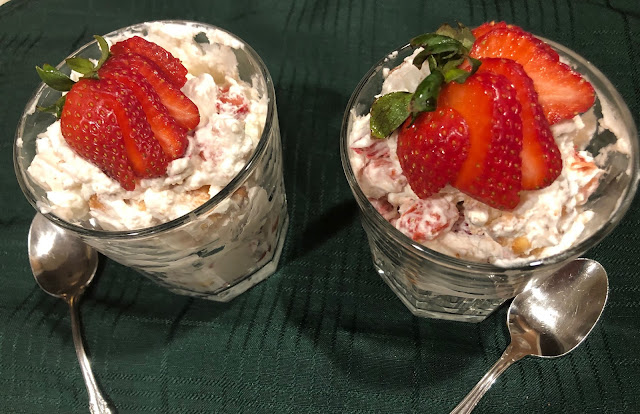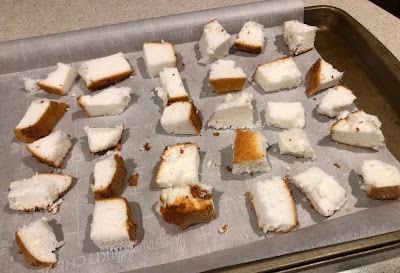
Recipe: Strawberries star in no-fuss dessert
 |
|
A strawberry fan tops off the strawberry-cream-cake dessert. (Photos:
Kathy Morrison)
|
The British dessert known as Eton mess has been on my dessert bucket list for awhile. It's named for Eton College, where the sweet creation is served after the traditional Eton-Harrow cricket match. Fresh strawberries are the stars, diced and allowed to macerate in a little sugar. They're swirled into a concoction of fresh whipped cream and broken pieces of crunchy meringue. Sounds like spring, right?
(The origin of the dessert isn't clear, but it seems likely that a dessert accident -- maybe dropped? crushed? sat on? -- was a contributing factor. The dessert called pavlova, after the celebrated Russian ballerina, also has meringue, cream and fruit, and may have been the starting point.)
 |
|
The angel food cake slices were cut into chunks. After trying
varied sizes, I decided smaller was better: more crunch.
|
Well, I didn't feel like making my own meringues -- I had gardening to do! -- and I couldn't find any meringue cookies in my COVID-limited sphere. So I went with the next best thing: toasted pieces of an angel food cake I'd found in the supermarket bakery department. That'd be crunchy, sweet and airy, right? So I had to rename the dessert.
I also picked up a few tips along the way about the ingredients, which can come across as too sweet without something to cut through the sugar. Lemon zest and just a bit of mascarpone cheese (or sour cream, crème fraîche or plain yogurt) do just that.
Raspberries or blackberries also would be delicious in this, though you'd have to crush them a bit to get some juice going. (Lime zest instead of lemon works best for these berries.) This recipe will serve 4 easily -- 6 after a big dinner, since it's surprisingly rich.
Don't mix the prepared ingredients together until just before serving or the toasted cake will get soft. Then you'd have something approaching trifle, which is another spring dessert altogether!
Strawberry Angel's Mess
Serves 4-6
Ingredients:
 |
|
The ingredients are all prepped and ready to combine. I decided
later that more strawberries than I have here would be better,
so the recipe reflects that.
|
Comments
0 comments have been posted.Sacramento Digs Gardening to your inbox.
Sites We Like
Garden Checklist for week of July 21
Your garden needs you!
* Keep your vegetable garden watered, mulched and weeded. Water before 8 a.m. to reduce the chance of fungal infection and to conserve moisture.
* Feed vegetable plants bone meal, rock phosphate or other fertilizers high in phosphate to stimulate more blooms and fruiting. (But wait until daily high temperatures drop out of the 100s.)
* Don’t let tomatoes wilt or dry out completely. Give tomatoes a deep watering two to three times a week.
* Harvest vegetables promptly to encourage plants to produce more. Squash especially tends to grow rapidly in hot weather. Keep an eye on zucchini.
* Pinch back chrysanthemums for bushy plants and more flowers in September.
* Remove spent flowers from roses, daylilies and other bloomers as they finish flowering.
* Pinch off blooms from basil so the plant will grow more leaves.
* Cut back lavender after flowering to promote a second bloom.
* It's not too late to add a splash of color. Plant petunias, snapdragons, zinnias and marigolds.
* From seed, plant corn, pumpkins, radishes, winter squash and sunflowers.